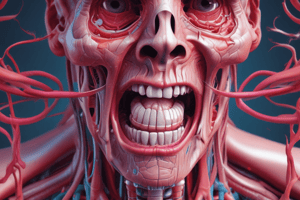Podcast
Questions and Answers
Which type of mucosa is characterized by a stratified squamous epithelium and is present in the gingiva and hard palate?
Which type of mucosa is characterized by a stratified squamous epithelium and is present in the gingiva and hard palate?
- Masticatory mucosa (correct)
- Dermal mucosa
- Specialized mucosa
- Lining mucosa
What is the primary function of serous cells in the salivary glands?
What is the primary function of serous cells in the salivary glands?
- Fat storage
- Secretion of proteins and polysaccharides (correct)
- Vitamin absorption
- Mucus production
What structural feature distinguishes the red region of the lip?
What structural feature distinguishes the red region of the lip?
- Presence of sweat glands
- Non-keratinized epithelium
- Tall papilla containing blood vessels (correct)
- Absence of blood vessels
Which salivary gland is noted for being purely serous?
Which salivary gland is noted for being purely serous?
Which type of papillae is associated with tasting bitter flavors?
Which type of papillae is associated with tasting bitter flavors?
What is the primary function of myoepithelial cells within salivary glands?
What is the primary function of myoepithelial cells within salivary glands?
Which of the following tonsils is located at the base of the tongue?
Which of the following tonsils is located at the base of the tongue?
Which of the following regions bounds the vestibule or buccal cavity?
Which of the following regions bounds the vestibule or buccal cavity?
What is the epithelium type found in the intercalated ducts of the sublingual gland?
What is the epithelium type found in the intercalated ducts of the sublingual gland?
Which type of epithelium would you find as the duct approaches the oral epithelium?
Which type of epithelium would you find as the duct approaches the oral epithelium?
What type of cells primarily line the esophageal epithelium?
What type of cells primarily line the esophageal epithelium?
Which statement correctly describes the muscularis externa of the esophagus?
Which statement correctly describes the muscularis externa of the esophagus?
What is the primary characteristic of the esophageal submucosa compared to the lamina propria?
What is the primary characteristic of the esophageal submucosa compared to the lamina propria?
What type of epithelium lines the larger diameter excretory ducts?
What type of epithelium lines the larger diameter excretory ducts?
In the context of the esophagus, what is the significance of the gastroesophageal junction?
In the context of the esophagus, what is the significance of the gastroesophageal junction?
Which type of ducts contains tall columnar epithelium in the sublingual gland?
Which type of ducts contains tall columnar epithelium in the sublingual gland?
Flashcards are hidden until you start studying
Study Notes
Oral Cavity Structures
- The oral cavity consists of the vestibule, oral cavity proper, and three types of mucosa: lining, masticatory, and specialized.
- Vestibule: Space between the cheeks/lips and teeth/gums.
- Oral cavity proper: Extends from behind the teeth/gums to the throat.
- Lining mucosa: Stratified squamous epithelium, submucosa in specific regions.
- Masticatory mucosa: Covers gingiva and hard palate.
- Specialized mucosa: Found on the dorsal surface of the tongue.
Lip Structure
- Lip consists of three regions: cutaneous, red, and oral mucosa.
- Cutaneous region: Covered by thin skin with keratinized stratified squamous epithelium, hair follicles, sebaceous, and sweat glands.
- Red region: Stratified squamous epithelium supported by tall papillae containing blood vessels, giving it a red color.
- Oral mucosa region: Continuous with the mucosa of the cheeks and gums.
Tonsils
- Lymphatic nodules clustered around the posterior opening of the oral and nasal cavities.
- Form the tonsillar (Waldeyer's) ring.
- Palatine tonsils: Posterior to the opening of the auditory tube.
- Tubal tonsils: Posterior to the opening of the auditory tube.
- Pharyngeal tonsils (adenoids): Roof of the nasopharynx.
- Lingual tonsils: Base of the tongue.
Tongue Structure
- Dorsal surface divided into anterior (2/3) and posterior (1/3) by the sulcus terminalis.
- Foramen cecum: Apex of the "V" shaped sulcus terminalis.
- Papillae on the tongue surface:
- Filiform papillae: Most numerous, cone-shaped, keratinized.
- Fungiform papillae: Mushroom-shaped, contain taste buds.
- Circumvallate papillae: Large, circular with taste buds and Von Ebner's glands.
- Foliate papillae: Located on the lateral margins of the tongue.
Salivary Glands
- Parotid gland: Pure serous, produces watery saliva with ptyalin (amylase enzyme).
- Submandibular gland: Mixed (serous and mucous), produces both watery and viscous saliva.
- Sublingual gland: Mixed, produces mainly viscous saliva.
- Connective tissue septa divide glands into lobules.
- Acini form the secretory units.
- Myoepithelial cells surround acinar cells, aiding in saliva expulsion.
Secretory Portions of Salivary Glands
- Serous cells: Round, single, basally located nucleus.
- Well-developed Golgi complex, abundant basal mitochondria.
- Secrete protein and polysaccharides.
- Secrete abundant secretory granules rich in ptyalin.
- Mucous cells: Pyramidal shape with flattened nucleus.
- Fewer mitochondria and less extensive GER.
- More prominent Golgi complex.
Salivary Gland Duct System
- Intercalated ducts: Low columnar or cuboidal epithelium.
- Striated ducts: Tall columnar epithelium, responsible for modifying saliva.
- Interlobular ducts: Pseudostratified epithelium.
- Main duct of the gland: Lined with ciliated epithelium.
Excretory Ducts
- Small ducts: Simple cuboidal epithelium.
- Larger diameter ducts: Stratified cuboidal or pseudostratified columnar epithelium.
- Near oral epithelium: Stratified squamous epithelium.
Palate Structure
- The palate is the roof of the mouth.
- Hard palate: Anterior portion supported by bone.
- Soft palate: Posterior portion made of muscle and connective tissue.
Esophagus Structure
- Esophageal epithelium: Non-keratinized stratified squamous epithelium.
- Esophageal lamina propria: Less cellular than stomach and intestine.
- Esophageal muscularis mucosae: Thicker than stomach and intestine, with longitudinal muscle fibers.
- Esophageal submucosa: Contains esophageal glands.
Muscularis Externa of the Esophagus
- Inner circular layer and outer longitudinal layer of smooth muscle.
- Auerbach's plexus located between the two muscle layers.
Studying That Suits You
Use AI to generate personalized quizzes and flashcards to suit your learning preferences.




